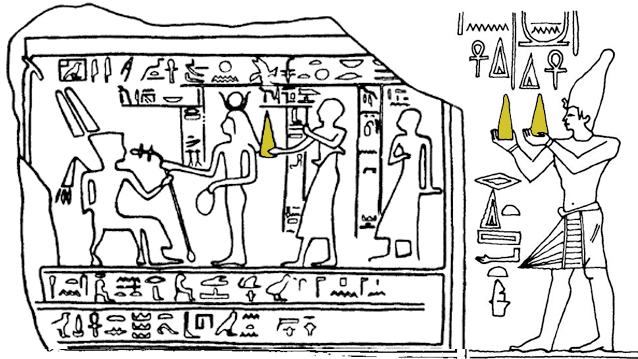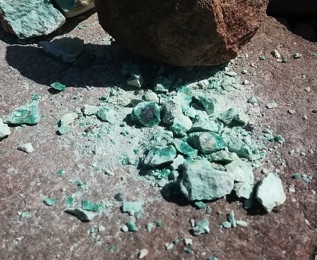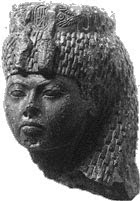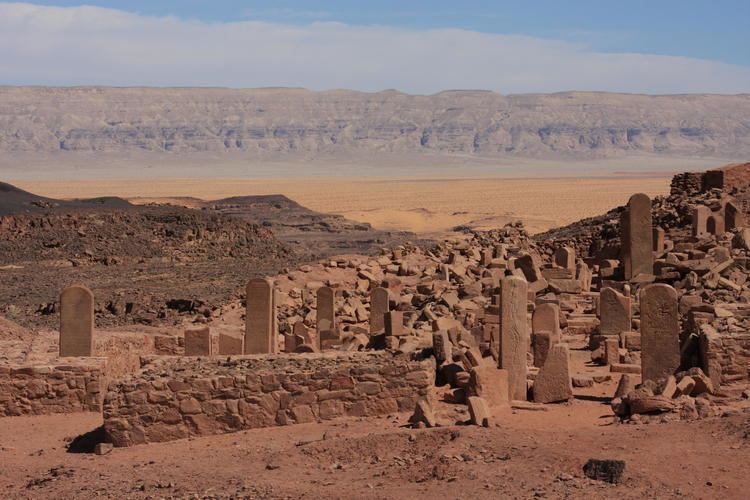Serabit el-Khadim (Arabic: سرابيط الخادم) is a locality in the southwest Sinai Peninsula, Egypt, where turquoise was mined extensively in antiquity, mainly by the ancient Egyptians. Archaeological excavation, initially by Sir Flinders Petrie, revealed ancient mining camps and a long-lived Temple of Hathor, the Egyptian goddess who was favoured as a protector in desert regions.
The mines were worked by people who presumably spoke a Northwest Semitic language.
The Serabit el-Khadim, The "Mfkzt" at Sinai
Why was there such an important Egyptian temple situated on top of a desolate mountain hundreds of miles away from the center of power in Sinai at At the Serabit el-Khadim? What made this site sacred and important to the Egyptians?
The cave of Hathor was cut into the rock. Inside the cave Petrie found an Ammarna statue-head of Akhenaton's mother, Queen Tiye, with her cartouche set in the crown. In the courts and halls of the outer temple were numerous stone-carved rectangular tanks and circular basins, along with a variety of curiously shaped bench-like altars with recessed fronts and split-level surfaces. The explorers found a metallurgist's space in which metals or other substances might have been melted or subjected to very high temperatures. They found a considerable amount of pure white powder concealed beneath carefully laid flagstones.
Egyptologists argue over why a melting space would have been necessary in a temple? They also debate the significance of a mysterious substance called MFKZT (pronounced mufkuzt), which was mentioned several times in the inscriptions at the site. Some believed that MFKZT might have been copper, or turquoise or malachite; however, the site contained no traces of any of these materials.
After further questioning, it was suggested that the white powder might have been a remnant of copper smelting. However, as experts in this field pointed out, smelting does not produce white powder, but leaves a dense black slag. Others guessed that the powder was ash from burning plants to produce alkali, but that was also not the case. It seems that the white powder was associated with certain sacrificial rite.
According to the German Philologist Karl Richard Lepsius, who had discovered the word "MFKZT" in Egypt back in 1845, the word signifies some form of stone that was extremely valuable and unstable.
The Mystery of the Conical Bread at Serabit in Sinai
Innumerable inscriptions referring to “bread” were unearthed at the Serabit site. This further increased the wonderment of the scientists. Close to the entrance of Hathor’s cave, they found a rock tablet depicting King Tuthmosis IV in the presence of Hathor. Before the king were two offering stands topped with lotus flowers, and behind him stood a man bearing a conical object described as “white bread.” Another stela detailed the mason Ankhib offering two conical bread cakes to the king. Yet another representation was found in a depiction of Hathor and Amenotep III. In it, the goddess Hathor is offering the emblem of life and dominion to the Pharaoh. Behind her is the treasurer Sobekhotep, who holds a conical loaf of "white bread." It should be noted that the treasurer Sobekhotep is described in the inscriptions as the man who “brought the noble Precious Stone to His Majesty.” Elsewhere, Sobekhotep is said to be the "Great One over the secrets of the House of Gold."
Interestingly, the 18th dynasty's royal treasurer (of whom and where?) was depicted presenting conical objects described as "white bread." He was regarded as the prestigious guardian of the house of gold.








A New Perspective
The ancient tribes who inhabited the region of Petra in particular had a unique perspective about plants and their alkaloidal effect. They saw things first hand in rocks where plants flourish. They saw which plant grows well on which color of rock formation, or a vein in a rock formation or mineral band. They were natural botanists and alchemists by virtue of their land and its fascinating geology. They also understood the influence of these minerals on different plant species; they knew which plants were poisonous and which were medicinal.
From a scientific point of view, several veins and rocks contains minerals or elements that are in a Monoatomic state. The Monoatomic state is only possible with what the scientific community calls “the transition element group.” This group of elements is found in nature in a non-metallic state. To understand more about it- and how it relates to the alchemical mysteries in this book, we need to learn about the story behind the discovery of this material and its properties.
The story begins in Arizona, a land whose geology is similar to that of the Southern Jordan. It is the story of ingenuity and creativity of late David Hudson of Phoenix. David Hudson was a wealthy third-generation cotton farmer whose father had been Commissioner of Agriculture for the state. He owned and farmed a giant ranch.
A natural difficulty with farming in Arizona is that the soil suffers from high sodium content, thereby causing the surface to be crunchy, black, and impenetrable by water. To combat this, David broke down the soil to make it suitable for his crops. By accident he isolated a fine powdery material with unique properties, and he started experimenting with it.
Commenting on his experience after separating the white substance from the soil, Hudson said in his Portland lecture, July 28, 1995:
“I really became intrigued with this stuff. What would happen if we give this material to people? It’s not metal-metal bonding so it doesn’t have heavy metal properties. So first of all we got a golden retriever and gave the material to the golden retriever. This golden retriever had tick fever, valley fever and a large abscess here on his side. And none of the veterinarians could find any medicine that would get rid of it due to the combination of all three diseases. And they just gave up; they weren't going to cure him. We began giving him one cc injections of one milligram of the white powder. One shot in the tumor and one shot in the blood stream. After a week and a half the tick fever was gone, the valley fever was gone, the tumor has shrunk down and disappeared. So we stopped the injections. About a week later it starts coming back again. So we start giving the injections again and it shrunk back down again. This time we continued about a week longer and then when we stopped it never came back. I am not a doctor.”
“And what we have done is we have given it in the high amounts to some people who have had nothing wrong with them medically. We didn't know what to expect. So the very first man, he did a 42 day food fast, which is pretty severe food fast. He went for 9 days with only water, he had a high colonic, and on the 10th day we began to give him 500 mg a day of this material”
“After 5 or 6 days of taking this material, this fellow began to hear this very high frequency sound, and every day the sound gets louder and louder. By the time he finished his fast, he said it's like loudspeakers in my brain, literally roaring this sound.”
“Well this sound is roaring in this man's head, it's roaring day and night, it's roaring when he’s talking on the phone, it's roaring when he's working. And I said, "Doesn't this disturb you? Isn't this an irritating sound? " and he said, "Not at all. It's just like nectar, because it doesn't come through the ears.” He said, "It’s inside the brain."
